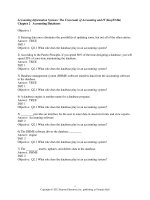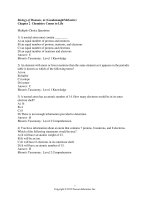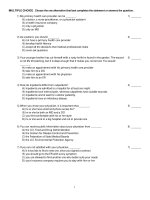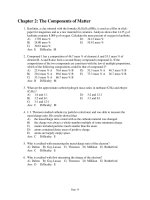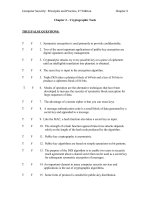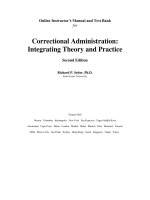Theory and practice of family therapy and counseling 2nd edition bitter test bank
Bạn đang xem bản rút gọn của tài liệu. Xem và tải ngay bản đầy đủ của tài liệu tại đây (588.16 KB, 18 trang )
Test Questions for Chapter One:
Instructions: Indicate the correct or best answer from each of the choices provided in each of the
multiple-choice questions:
1.
Modern family practice was first practiced in public as early as:
A.
B.
C.
D.
ANS: A
2.
1920s
1940s
1960s
1980s
PG: 5
Which of the following is true?
A.
B.
C.
D.
In the US, family therapy developed into a field of therapy in the 1970s
Family therapy promised greater potential for change because of the focus on the
family as a system
While not all hopes for the field have been realized, the field has demonstrated
success
All of the above
ANS: D PG: 5
3.
In reviewing different theories and practices of family therapy and counseling, an
epistemological question—like “What beliefs do these theorists and practitioners have
about families in general?”—is important, because:
A.
B.
C.
D.
It looks at the foundation that underlies the approach
It can lead to self-reflective questions, like “Do I believe the same thing or
something else?”
It can lead to pragmatic questions, like “Would I go to this kind of therapy with
my family? Why or why not?”
All of the above
ANS: D PG: 6
4.
Starting with the development of your personal family autobiography will afford you a
chance to:
A.
B.
C.
D.
ANS: C
5.
Become self-absorbed rather than theory-bound
Analyze and finally make sense of your family dynamics
Anticipate issues or concerns that might one day be present in your own family
practice
None of the above
PG: 7
The Commission on Accreditation for Marriage and Family Therapy Education is
associated with the epistemology, standards, and practices of which professional
organization?
A.
B.
C.
D.
American Counseling Association
American Association for Marriage and Family Therapy
International Association of Marriage and Family Counselors
Council for the Accreditation of Counseling and Related Educational Programs
ANS: B PG: 11
6.
Which of the following is true about the International Association of Marriage and
Family Counselors?
A.
B.
C.
D.
It is a subdivision of the American Counseling Association
It is a subdivision of the American Association for Marriage and Family Therapy
Its standards for practice have yet to be developed and are not part of any
accreditation process at the moment
Its standards for practice are represented within the Commission on Accreditation
for Marriage and Family Therapy Education
ANS: A PG: 11
7.
In which of the theories that will be presented in this book will you most likely address
the concepts of genograms, differentiation of self, and triangulation?
A.
B.
C.
D.
Bowen’s multigenerational family therapy
Whitaker’s symbolic-experiential family therapy
Solution-focused/ solution-oriented family therapy
None of the above
ANS: A PG: 14
8.
In which of the theories that will be presented in this book will you most likely find an
emphasis on patriarchy and gender issues?
A.
B.
C.
D.
Satir’s human validation process model
Strategic family therapy
Feminist family therapy
None of the above
ANS: C PG: 15
9.
System assessments focus on interactions rather than individual experience. Interactions:
A.
B.
C.
D.
Involve a defined cause as well as a defined effect
Can be described in such a way that the why of the interaction is obvious
May involve messages and metamessages (or directions about how to understand
the messages)
Are random and tend to
lack purpose or sequence
ANS: C PG: 16
10.
Which of the following people is credited with introducing the concepts of bio-ecological
systems theory to understanding family systems?
A.
B.
C.
D.
Norman Wheeler
Urie Bronfenbrenner
Milton Erickson
Erik Erikson
ANS: B PG: 17
11.
Which of the following is the impact that occurs when two microsystems interact?
A.
B.
C.
D.
Chronosystem
Mesosystem
Exosystem
Macrosystem
ANS: B PG: 18
12.
The Family Life Cycle is an example of which of the following?
A.
Microsystem
B.
C.
D.
Mesosystem
Chronosystem
None of the above
ANS: C PG: 18
13.
Which of the following groups are considered part of the normal families in the United
States?
A.
B.
C.
D.
Single parent families
Dual career families
Unmarried couples with children
All of the above
ANS: D PG: 19
14.
The ability to adapt, change, and recover after adversity is called:
A.
B.
C.
D.
resilience
recovery
re-orientation
realization
ANS: A PG: 20
Wacky Questions To Ask Just For Fun:
1.
Family counseling is to family therapy as:
A.
B.
C.
D.
A kangaroo is to a wallaby
A medical doctor is to a surgical nurse
A home builder is to the plumber
None of the above
ANS: D
2.
Resilience is:
A.
the feeling you have when you have been silly and then decide to be
again, sort of a "re-silly-ence"
B.
The name of a new movie about and starring Lindsey Lohan
C.
D.
ANS: D
A song by Eminem
None of the above
Key Term Questions:
1.
The accreditation body for AAMFT is called COAMFTE. COAMFTE stands for
___________________________________________________. [Council for the
Accreditation of Marriage and Family Therapy Education]
PG: 11
2.
The accreditation body for the American Counseling Association of which IAMFC is a
subdivision is called CACREP. CACREP stand for
___________________________________________________. [Council for the
Accreditation of Counseling and Related Educational Programs]
PG: 11
3.
Urie Bronfenbrenner's systemic concept that explains the impact on the individual due to
an interaction with environments that do not directly affect the person is called
__________________.
[exosystem]
PG: 18
4.
The Becvars prefer a different term than family therapy for the systemic practice
advocated in this book. Their term is: ______________________. [Relational therapy]
PG: 22
5.
A family that is able to rebound after facing adversity is said to have
__________________. [Resilience]
PG: 20
Short Answer Questions:
1.
Explain the difference between individual and family therapy.
2.
Explain the difference microsystems, mesosystems, and macrosystems.
3.
Explain the difference between AAMFT and IAMFC.
4.
How would the concept of resilience work in a family system and what would it mean for
the practice of family therapy?
5.
How might individual and family therapy differ in their approach to helping a person
with depression?
Test Questions for Chapter Two:
Instructions: Indicate the correct or best answer from each of the choices provided in each of the
multiple-choice questions:
1.
The first practice of family therapy was:
A.
B.
C.
D.
Freud with Little Hans
Adler in an open forum
Minuchin in Israel
Haley at MRI
ANS: B PG: 26
2.
Which of the following contributed to the development of Object Relations theory?
A.
B.
C.
D.
Fairbairn
Winnicott
Mahler
All of the above
ANS: D PG: 11
3.
Which of the following started their careers at the Menninger Clinic?
A.
B.
C.
D.
Ackerman & Bowen
Satir & Whitaker
Minuchin & Haley
All of the above
ANS: A PG: 26
4.
The first journal devoted to family practice was called:
A.
B.
C.
D.
Journal of Family Counseling
The Family Journal
Family Process
International Journal of Sociology of the Family
ANS: C PG: 26
5.
Ivan Boszormenyi-Nagy worked with which of the following family practitioners?
A.
B.
C.
D.
Gerald Patterson
Geraldine Spark
Nathan Ackerman
Harry Aponte
ANS: B PG: 27
6.
The two central issues for Ivan Boszormenyi-Nagy were:
A.
B.
C.
D.
trust and loyalty
fear and courage
love and responsibility
will and power
ANS: A PG: 27
7.
Most modern parenting programs are based on the approaches associated with
A.
B.
C.
D.
Adler & Dreikurs
Bowen & Satir
Minuchin & Haley
None of the above
ANS: A PG: 27
8.
The undifferentiated family ego mass is associated with which of the following
theorist/therapists?
A.
B.
C.
D.
David Scharff
Alfred Adler
Murray Bowen
None of the above
ANS: C PG: 28
9.
Which of the following people was involved in the creation of genograms and the family
life cycle?
A.
B.
James Framo
Gerald Zuk
C.
D.
Monica McGoldrick
Charles Fishman
ANS: C PG: 28
10.
Whitaker and John Warkentin started their career together in Oak Ridge, TN, before
moving to Atlanta and Emory University. In Atlanta, they would work with which of the
following people?
A.
B.
C.
D.
Harry Aponte
Gus Napier
Milton Erickson
Lynn Hoffman
ANS: B PG: 29
11.
Many family practitioners refer to which book as the first classic in Family Therapy?
A.
B.
C.
D.
Families and Family Therapy
The Family Crucible
Peoplemaking
Narrative Means to Therapeutic Ends
ANS: B PG: 29
12.
Which of the following people made a career transition from the west coast to the east
coast, from MRI to Ackerman, and from strategic family therapy to a postmodern, social
constructionist model of therapy?
A.
B.
C.
D.
Jay Haley
Cloe Madanes
Lynn Hoffman
None of the above
ANS: C PG: 30
13.
The parents of a 14-year-old high school student have been contemplating a divorce until
the child tries to commit suicide, and the parents stay together to care for her. The
sequence just described is an example of:
A.
B.
A positive feedback loop leading to second-order change
A negative feedback loop leading to first-order change
C.
D.
A positive feedback loop leading to first-order change
A negative feedback loop leading to second-order change
ANS: B PG: 34
14.
Transformational changes that endure and make a real difference are called:
A.
B.
C.
D.
First-order changes
Second-order changes
Third-order changes
Fourth-order changes
ANS: B PG: 35
15.
When two opposing directives are given, and neither can be ignored, tolerated, nor
dismissed (that is, the person cannot win and cannot escape):
A.
B.
C.
D.
The person is experiencing what Gregory Bateson called a double bind
The person has a pathology
The system is experiencing a paradox
The person can only feel stuck
ANS: A PG: 35
Wacky Questions To Ask Just For Fun:
1.
A genogram:
A.
Is a measure of weight
B.
A telegram from a little guy in a bottle
C.
A text to your grandmother turning down her offer to smooch your friends, as in
"Gee, no, Gramma.”
D.
None of the above
ANS: D
2.
A negative feedback loop is:
A.
B.
C.
D.
ANS: D
President Obama talking with John Boehner
Bill Clinton explaining things to Hillary
Rocky counseling Bullwinkle
All of the above
Key Term Questions:
1.
The women's project evolved out of a meeting of women in 1984 called:
___________________________________________________. [the Stonehenge
Conference]
PG: 43
2.
The accepted term for effective parenting today is:
___________________________________________________. [authoritative-responsive
par]
PG: 46
3.
Norbert Wiener’s systemic concept that explains how feedback informs systems and
either keeps them the same or changes them is called __________________.
[Cybernetics]
PG: 34
4.
The most used model of therapy in general in managed care systems is called
______________________. [CBT or Cognitive-Behavioral Therapy]
PG: 46
5.
A mapping process shared across family therapy models that gives structure and
emotional resonance to understanding families and even professional systems is called:
__________________. [Genogram]
PG: 25
Short Answer Questions:
1.
Explain the difference between Satir and Whitaker's experiential approaches.
2.
What parts of early Freudian and Object Relations theories are most present in modern
Object Relations Family Therapy?
3.
Explain the differences between the three approaches to strategic family therapy.
4.
What are some of the differences between modern and postmodern approaches to family
therapy?
5.
Arrange the following people on a timeline of family therapy and indicate one unique
thing each contributed to family therapy: The people are Adler, Satir, Minuchin, Haley,
& White.
Test Questions for Chapter Three:
Instructions: Indicate the correct or best answer from each of the choices provided in each of the
multiple-choice questions:
1.
Which of the following accounts for the most change or success in therapy?
A.
B.
C.
D.
A client who is educated, motivated, and engaged in therapy
The setting in which the therapist works
The model the therapist uses
The techniques or interventions of the therapist
ANS: A PG: 63
2.
Which of the following is true?
A.
B.
C.
D.
Bowen considered a differentiated self essential to the development of a family
therapist
It is wise to know what triggers or buttons you have so that you won’t have them
pushed all the time in therapy
The person and the practice of therapy cannot be separated; each affects the other
All of the above
ANS: D PG: 52
3.
Which of the following are tools that a therapist might use to learn about self and self in
relation to others?
A.
B.
C.
D.
A genogram of one’s extended family-of-origin
Satir’s wheel of influence
Historical timeline of one’s own family
All of the above
ANS: D PG: 53
4.
Satir’s “Hanging Hats” exercise is a systemic way of considering and addressing
processes that therapists seeing individuals call:
A.
Psychosexual developmental issues
B.
C.
D.
Dysfunctional or pathological family processes in general
Transference and counter-transference issues
None of the above
ANS: C PG: 55
5.
One way to stay present with families and make contact is to ask yourself the following
question:
A.
B.
C.
D.
What does my theory tell me is the right thing to do when I get into a family
session, and am I following the theory’s requirements?
Who am I meeting at this moment in time, and what do they want me to know
about their thoughts, feelings, interactions, and behaviors?
What will my supervisor think of what I am doing right now?
How am I doing as a new counselor or therapist?
ANS: B PG: 57
6.
It is often hard to genuinely care about specific people in a family before the family
practitioner even meets the family. If not caring, what can the counselor or therapist bring to the
first session?
A.
B.
C.
D.
Interest in the clients and a desire to create an atmosphere of safety
More knowledge and education than the family members are likely to have
An ability to diagnose problems and formulate treatment plans
The original premise is wrong; you should learn to care about your clients even
before you meet them
ANS: A PG: 57
7.
Teleology is the study of:
A.
B.
C.
D.
goals and purposes
symbolic interactions
metaphorical languaging
None of the above
ANS: A PG: 58
8.
Which of the following is most associated with the idea of holism?
A.
B.
C.
D.
Taking into account that each part of a system is actually greater than the sum
represented by the whole
Learning strategies for taking dysfunctional parts of individuals and integrating
them into a whole
Working in patterns and seeing people and systems in context
None of the above
ANS: C PG: 58
9.
Which of the following will serve a beginning family practitioner well?
A.
B.
C.
D.
Staying focused on universal humanism and not getting caught up in diversity
issues
Absorbing the issues and concerns of clients so that you can take them home with
you and study them—or at least worry about them
Having a sincere interest in the welfare of others
Leaving the spirit of the family and its members to their priest or minister and
focusing only on psychologically-based understandings of people and their
actions
ANS: C PG: 59
10.
In which part of Satir’s process of change do family routines and patterns continue as
they normally do?
A.
B.
C.
D.
Status quo
Introduction of foreign element
The experience of chaos
The generation of new possibilities
ANS: A PG: 59
11.
Which of the following might be considered a general guideline in therapy?
A.
B.
C.
D.
Disarray and disengagement are better than a stagnant status quo
It is better for family systems to be open and organized rather than disorganized
or closed
Emotional reactivity is better than no reaction at all
Optimism, faith, and courage often get in the way of fully appreciating one’s fear
and the need to acknowledge it
ANS: B PG: 59
12.
Which of the following is most true?
A.
B.
C.
D.
Studying your own work can only make you self-conscious; just do what feels
right
Silence in therapy is a sign of discomfort and it should be filled with another
question or comment from the therapist
Be careful with giving advice
None of the above
ANS: C PG: 64
13.
One thing that the Journal of Marital and Family Therapy has demonstrated over the last
20 years is:
A.
B.
C.
D.
Marriage and family therapy can have negative and harmful effects
Marriage and family therapy is more efficacious than individual therapy in
treating schizophrenia, marital distress, or depressed women in a distressed
marriage
Some approaches to marriage and family therapy are more effective or superior to
other approaches
Residential treatment is still more cost effective than marriage and family therapy
alone when treating schizophrenia, delinquency, or severe conduct disorders
ANS: B PG: 65
14.
A research study that focuses on the meaning in the stories that people tell is most likely:
A.
B.
C.
D.
A quantitative study
A qualitative study based on narratives
An experimental study
An action study based on narratives that leads to transformational research
ANS: B PG: 65
15.
While marriage and family therapy may be a critical and necessary component of severe
problems, effective treatment often includes:
A.
B.
C.
D.
Individual or group counseling and/or medication
Hospitalization
Removal of identified patients from negative family systems
All of the above
ANS: A PG: 65
Wacky Questions To Ask Just For Fun:
1.
Of the following, who can be really grumpy people and still function in their profession?
A.
B.
C.
D.
ANS: D
2.
Rosie O’Donnell and Donald Trump
Russell Crowe and Mel Gibson
Family Counselors, Therapists, or Social Workers
“A” and “B,” but not “C”
Which of the following careers is least likely to make you rich and famous?
A.
B.
C.
D.
ANS: D
NFL football star
CEO of General Motors
Co-starring in a TV show with Paris Hilton
Family practitioner
Key Term Questions:
1.
A structural map of three generations of a family is called a _________________.
[genogram]
PG: 52
2.
Creating a ____________________ involves putting yourself at the center of a circle and
then drawing spokes out to people who are major influences in your life and the
adjectives that they represent. [wheel of influence]
PG: 53
3.
Satir’s process for clearing the mind and heart to be fully present after addressing the
pictures of people we project, what stands out, what we think stands out in us, first
impressions, and what third party information we have of others is called
__________________. [hanging hats]
PG: 55
4.
Understanding human patterns and processes within the social contexts that support them
is called ______________________. [holism]
PG: 55
5.
Being willing to accept oneself as an everyday human being who makes mistakes is,
according to Sophie Lazersfeld & Rudolf Dreikurs, having_______________. [the
courage to be imperfect]
PG: 61
Short Answer Questions:
1.
In general, what are some of the positive goals for individuals and families that the
helping professions might have?
2.
Explain what collaborative practice in therapy is and why it might be important to pursue
this process.
3.
List some of the findings, confirmed by research, related to the field of family practice.
4.
What is qualitative research and in what way might it be a good fit with family practice?
5.
What significance does a consideration of gender issues and multiculturalism play in
family practice?
